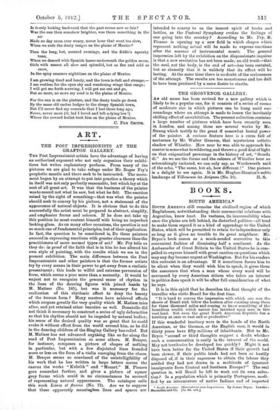ART.
THE posr IMPRESSIONISTS AT THE
GRAFTON GALLERY.
THE Post Impressionist artists have the advantage of having an authorized exponent who not only organizes their exhibi- tions but writes explanatory prefaces. From many of the pictures we are glad to take refuge under Mr. Roger Fry's prophetic mantle and there seek to be instructed. The move. went began by an attempt to put into practice a theory which in itself was not only perfectly reasonable, but which lay at the root of all great art. It was that the business of the painter was to record not what he saw, but what he felt. The emotion raised by the sight of something—that was what the painter should seek to convey by his picture, not a statement of the appearance of natural objects. It is obvious that to do this successfully the artist must be prepared to abstract, simplify, and emphasize forms and colours. If he does not take up this position he must content himself with being an imperfect looking-glass. As on many other occasions, the question is not so much one of fundamental principles, but of their application. In fact, the question to he considered is, Do these painters succeed in expressing emotions with greater clearness than the practitioners of more normal types of art? Mr. Fry tells us they do : in proof of the faith that is in him he has altered his own style of painting, with the results which we see in the present exhibition. The main difference between the Post Impressionists and other painters is that the former artists try by every means in their power to get away from a realistic presentment ; this leads to wilful and extreme perversion of form, which seems a pose more than a necessity. It would be unjust not to recognize the general sense of rhythm in the lines of the dancing figures with joined hands by M. Matisse (No. 185), but was it necessary for the realization of this rhythmic effect to deny the beauty of the human form ? Many masters have achieved effects which surpass greatly the very quality which M. Matisse tries after, and yet retained other beauties as well. Donatello did not think it necessary to construct a series of ugly deformities so that his rhythm should not be impeded by natural bodies ; his sense of the desired quality was so great that he could evoke it without effort from the world around him, as he did in the dancing children of the Singing Gallery bas-relief. But M. Matisse has not advanced anything like so far along the road of Post Impressionism as some others. M. Braque, for instance, composes a picture of shapes of nothing in particular, but with a few disjointed lines founded more or less on the form of a violin emerging from the chaos. M. Braque seems so convinced of the unintelligibility of his work that he has written in large letters across the canvas the works " Kubelik " and "Mozart." M. Picasso goes somewhat further, and gives a picture of square grey forms which could in no circumstances be accused of representing natural appearances. The catalogue calls this work Livres et flacons (No. 71). Are we to suppose that these apparently meaningless lines and spaces are intended to convey to us the inmost spirit of books and bottles, as the Pastoral Symphony evokes the feelings of one going into the country ? According to Mr. Fry, M. Picasso is opening up a new field in which shapes which represent nothing actual will be made to express emotions after the manner of instrumental music. The general impression left by the exhibition on the dispassionate inquirer is that a new revelation has not been made; an old truth—that the soul, not the body, is the end of art—has been restated, but so clumsily that it is unlikely that its effect will be lasting. At the same time there is no doubt of the seriousness of the attempt. The results are too monotonous and too dull to have been produced by a mere desire to startle.


































































 Previous page
Previous page